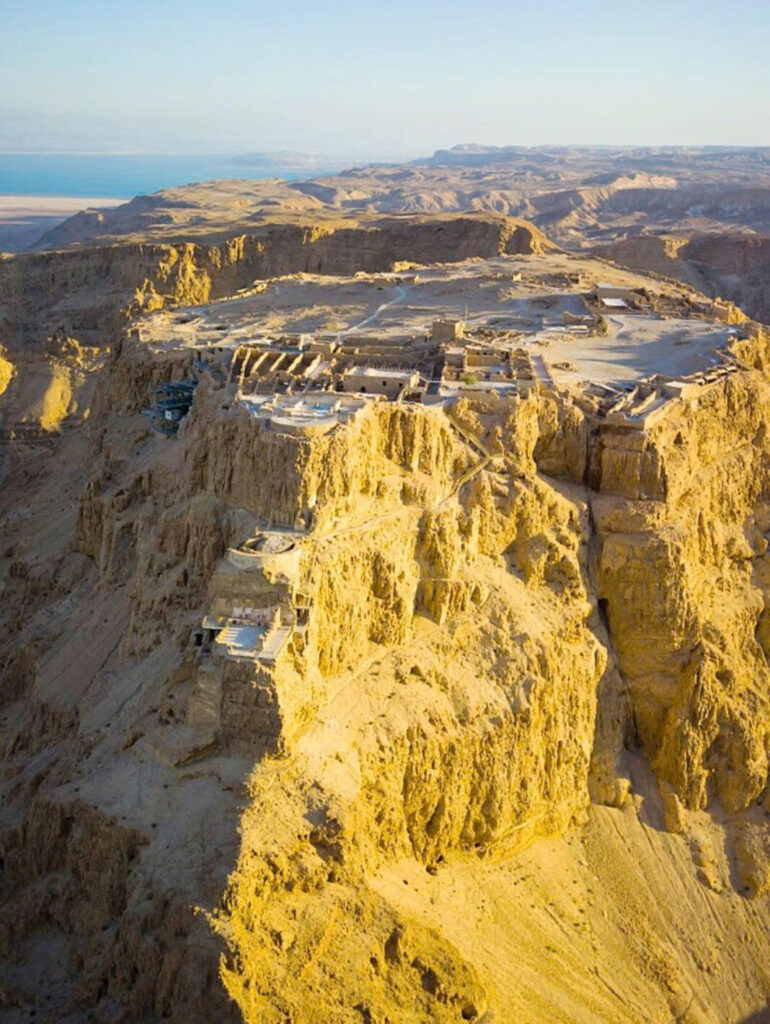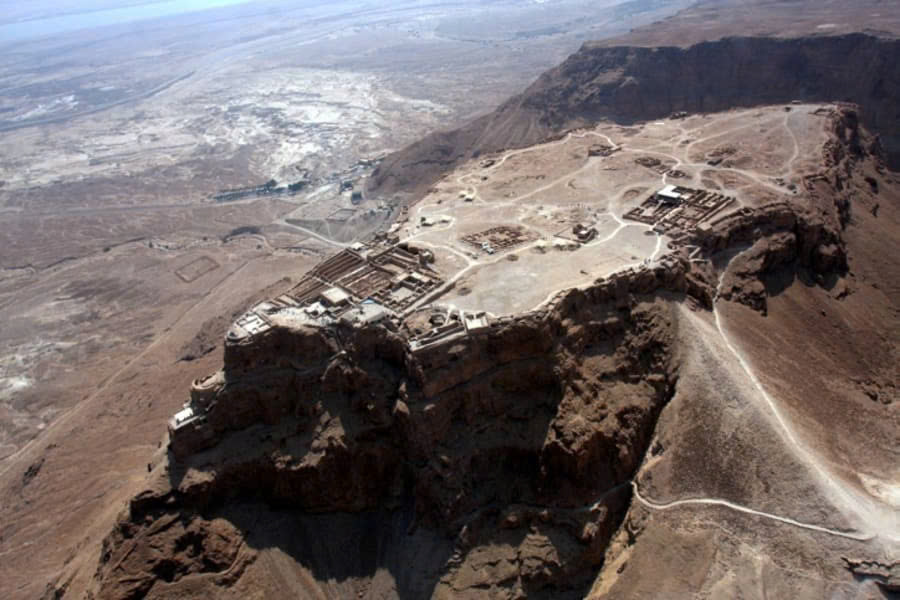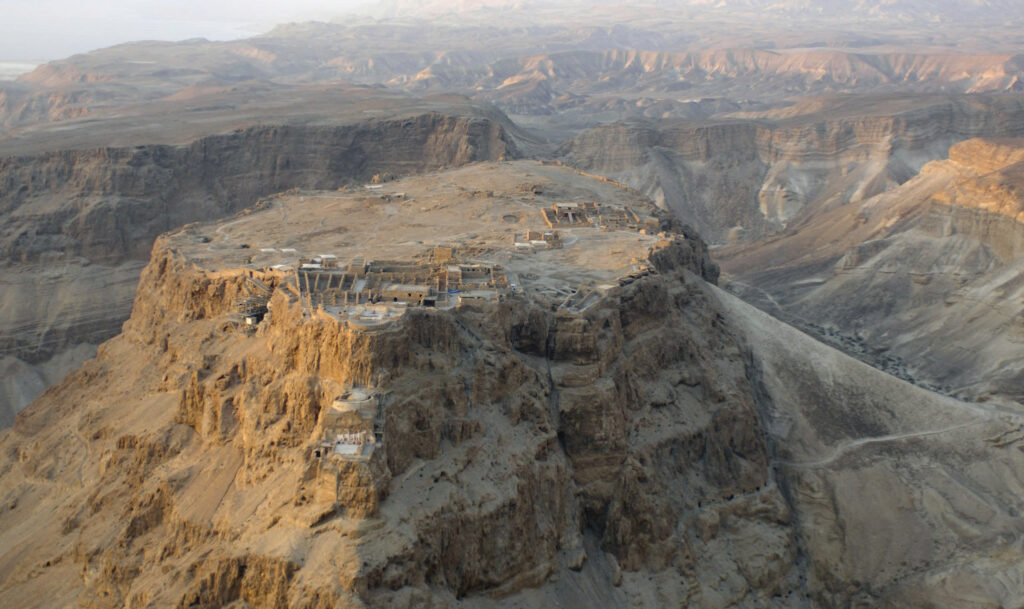A Fortress Born from Rebellion
High above the Dead Sea, on a windswept plateau that seems to touch the heavens themselves, stands the ancient fortress of Masada. This remarkable stronghold, originally constructed by King Herod the Great around 37-31 BCE, would become the stage for one of history’s most dramatic final acts of resistance against imperial Rome.

The fortress served as more than just a military outpost—it was a symbol of Jewish autonomy in a land increasingly dominated by foreign powers. Its strategic location, perched 1,300 feet above the desert floor, made it virtually impregnable to conventional assault, a fact that would prove crucial in the events that followed.
The Great Revolt and Its Aftermath
The Fall of Jerusalem
The year 70 CE marked a catastrophic turning point for the Jewish people. After years of rebellion against Roman rule, Jerusalem fell to the legions of General Vespasian and his son Titus. The magnificent Second Temple, the spiritual heart of Judaism, was reduced to rubble and ash. The city that had stood as the center of Jewish life for centuries lay in ruins, its population scattered or enslaved.
Yet even as the main revolt crumbled, pockets of resistance endured. Among these defiant holdouts were the families who had sought refuge in Masada’s seemingly impregnable walls.
The Last Refuge
For three years after Jerusalem’s destruction, these 967 Jewish men, women, and children maintained their independence atop Masada. They were not merely survivors—they were the final flame of the First Jewish Revolt, refusing to accept Roman dominion over their homeland.

The rebels included members of the Sicarii, a militant faction known for their uncompromising resistance to Roman occupation. Under the leadership of Eleazar Ben-Yair, they had transformed Herod’s former palace into a fortress of the free.
The Roman Siege: An Empire’s Determination
The Tenth Legion Arrives
The Roman Empire, having crushed the revolt elsewhere, could not tolerate this final bastion of resistance. The Tenth Legion, veterans of the Jerusalem campaign, marched across the harsh Judean Desert to lay siege to Masada. What they found was no ordinary fortress—it was a mountain citadel that seemed to mock their engineering prowess.
Engineering Marvel Against Nature’s Fortress
Faced with Masada’s natural defenses, the Romans embarked on one of their most ambitious siege projects. They constructed a massive earthen ramp against the mountain’s western face, a feat of engineering that required moving thousands of tons of stone and earth. The ramp, still visible today, stands as a testament to Roman determination and military innovation.

As the ramp grew higher day by day, the defenders watched their impregnable fortress become increasingly vulnerable. The writing was on the wall—Rome’s military machine would not be denied.
The Final Choice: Death Before Dishonor
Eleazar’s Fateful Decision
As Roman battering rams began their assault on the fortress walls, Eleazar Ben-Yair faced an impossible choice. Surrender meant slavery or execution for his people—a fate he deemed worse than death itself. According to the historian Flavius Josephus, Eleazar gathered the men of Masada and delivered a speech that would echo through history.
The Tragic Resolution
The decision they reached was as shocking as it was final. Rather than face capture, the defenders chose to end their lives on their own terms. In a carefully orchestrated plan, each man killed his own family, then the men drew lots to determine who would end the others’ lives. The process continued until only one remained, who set the palace ablaze before taking his own life.
Josephus recorded the haunting final moments: the last survivor “after surveying the prostrate multitude… and finding that all were slain, set the palace ablaze, and then collecting his strength drove his sword clean through his body and fell beside his family.”
Modern Pilgrimage: From Ancient Tragedy to National Symbol
The Snake Path and Cable Cars
Today, thousands of visitors make the journey to Masada each year. Some arrive via the modern highway along the Dead Sea’s western shore, while others approach from the town of Arad, following the path of the Roman ramp. The most adventurous climb the ancient Snake Path before dawn, watching the sun rise over the fortress where so much history unfolded.
A Symbol Reborn

After Israel’s establishment in 1948, Masada took on new meaning. The slogan “Masada shall not fall again” became a rallying cry for the young nation. The story of Jews choosing death over surrender resonated powerfully in the wake of the Holocaust and during Israel’s early years of perceived isolation.
Archaeological Mysteries and Modern Debates
The Search for Truth
The famous Israeli archaeologist Yigael Yadin excavated Masada from 1963-1965, uncovering remarkable evidence of the siege. Among the most intriguing discoveries were ostraca (inscribed pottery shards) found in the northern palace complex, some bearing names that might relate to the distribution of food among the defenders.
Video
The Lots Controversy
Twelve ostraca, written by the same hand and inscribed with Hebrew names including “ben Yair,” were initially identified as the lots mentioned by Josephus. However, scholars debate whether these artifacts truly represent the lots used in the mass suicide, or served some other purpose entirely.
Historical Skepticism
Modern scholarship has grown increasingly skeptical of Josephus’ account. Some historians argue that the mass suicide story may be fabricated—a literary device rather than historical fact. This debate reflects broader questions about how we interpret ancient sources and the role of archaeology in validating historical narratives.
Legacy and Transformation
From Rebels to Heroes
The transformation of Masada from the site of a tragic mass suicide into a symbol of heroic resistance represents one of history’s most remarkable rehabilitations. The Sicarii, who had terrorized Jewish settlements during the revolt, became freedom fighters in the modern Israeli narrative.
UNESCO Recognition

In 2001, Masada achieved UNESCO World Heritage status, becoming Israel’s first site to receive this recognition. It remains the second-most visited archaeological site in Israel, drawing pilgrims from around the world who come to stand where a small band of rebels made their final stand against the Roman Empire.
Evolving Perspectives
While Masada’s symbolic importance has evolved over time, it continues to resonate with visitors who see in its story themes of courage, sacrifice, and the price of freedom. Whether viewed as historical fact or powerful legend, the story of Masada remains a testament to the human spirit’s refusal to surrender in the face of overwhelming odds.
The fortress that King Herod built as a luxurious retreat became the stage for one of history’s most dramatic final acts—a reminder that sometimes the greatest victories come not in conquest, but in the courage to choose one’s own destiny.

